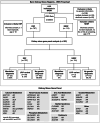Prevalence and characteristics of genetic disease in adult kidney stone formers
- PMID: 38544324
- PMCID: PMC11483609
- DOI: 10.1093/ndt/gfae074
Prevalence and characteristics of genetic disease in adult kidney stone formers
Abstract
Background: Molecular mechanisms of kidney stone formation remain unknown in most patients. Previous studies have shown a high heritability of nephrolithiasis, but data on the prevalence and characteristics of genetic disease in unselected adults with nephrolithiasis are lacking. This study was conducted to fill this important knowledge gap.
Methods: We performed whole exome sequencing in 787 participants in the Bern Kidney Stone Registry, an unselected cohort of adults with one or more past kidney stone episodes [kidney stone formers (KSFs)] and 114 non-kidney stone formers (NKSFs). An exome-based panel of 34 established nephrolithiasis genes was analysed and variants assessed according to American College of Medical Genetics and Genomics criteria. Pathogenic (P) or likely pathogenic (LP) variants were considered diagnostic.
Results: The mean age of KSFs was 47 ± 15 years and 18% were first-time KSFs. A Mendelian kidney stone disease was present in 2.9% (23/787) of KSFs. The most common genetic diagnoses were cystinuria (SLC3A1, SLC7A9; n = 13), vitamin D-24 hydroxylase deficiency (CYP24A1; n = 5) and primary hyperoxaluria (AGXT, GRHPR, HOGA1; n = 3). Of the KSFs, 8.1% (64/787) were monoallelic for LP/P variants predisposing to nephrolithiasis, most frequently in SLC34A1/A3 or SLC9A3R1 (n = 37), CLDN16 (n = 8) and CYP24A1 (n = 8). KSFs with Mendelian disease had a lower age at the first stone event (30 ± 14 versus 36 ± 14 years; P = .003), were more likely to have cystine stones (23.4% versus 1.4%) and less likely to have calcium oxalate monohydrates stones (31.9% versus 52.5%) compared with KSFs without a genetic diagnosis. The phenotype of KSFs with variants predisposing to nephrolithiasis was subtle and showed significant overlap with KSFs without diagnostic variants. In NKSFs, no Mendelian disease was detected and LP/P variants were significantly less prevalent compared with KSFs (1.8% versus 8.1%).
Conclusion: Mendelian disease is uncommon in unselected adult KSFs, yet variants predisposing to nephrolithiasis are significantly enriched in adult KSFs.
Keywords: kidney stones; mendelian; monogenic; nephrolithiasis; whole exome sequencing.
© The Author(s) 2024. Published by Oxford University Press on behalf of the ERA.
Conflict of interest statement
The authors declare no competing interests.
Figures



Comment in
-
Genetic kidney stones disease in adults.Nephrol Dial Transplant. 2024 Aug 30;39(9):1381-1383. doi: 10.1093/ndt/gfae099. Nephrol Dial Transplant. 2024. PMID: 38744536 No abstract available.
References
MeSH terms
Grants and funding
LinkOut - more resources
Full Text Sources
Miscellaneous

